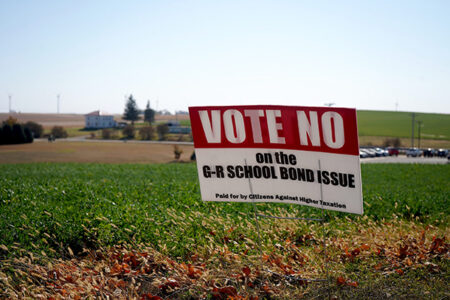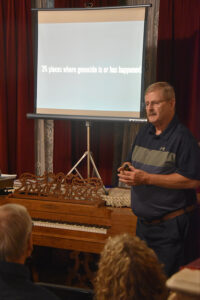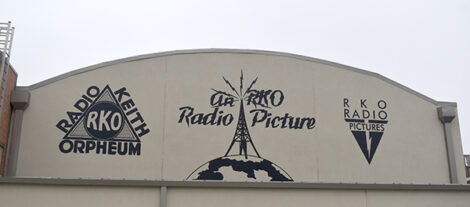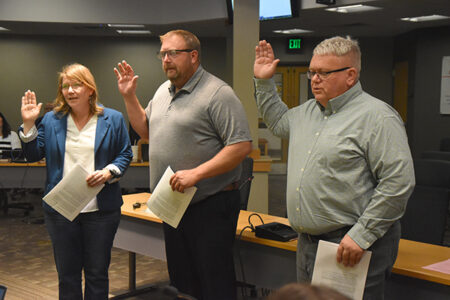‘We think the code is unreasonable’
MARSHALLTOWN President/CEO criticizes council over new development landscaping standards
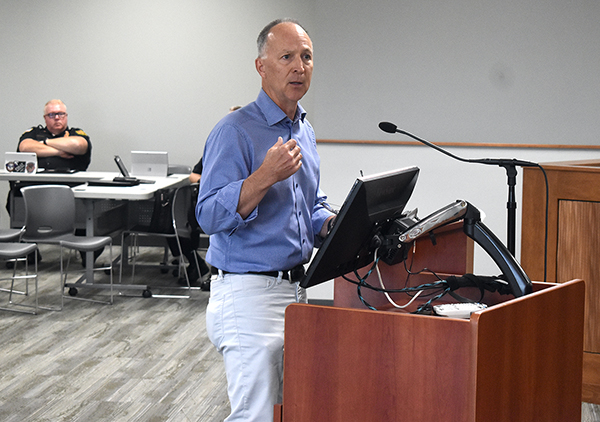
T-R PHOTO BY ROBERT MAHARRY MARSHALLTOWN Company President/CEO Joe Carter addressed the city council with concerns about the city’s new development landscaping standards and what he felt were excessive planting requirements during Monday night’s meeting. MARSHALLTOWN successfully applied for a variance from the stipulations with the Board of Adjustment.
The Marshalltown city council considered and approved several agenda items related to the expansion of MARSHALLTOWN Company during Monday night’s meeting, but the longest conversation of the night unfolded during a discussion item about the city’s updated landscaping standards for new development — which drew strong criticism from MARSHALLTOWN President/CEO Joe Carter.
As City Administrator Carol Webb explained, the standards were updated and approved in April of 2022, but the council recently received a letter from Carter questioning whether they were reasonable and allowed flexibility. She felt the requirements reflect the intent of the ordinance but added that the feedback raised questions about whether they achieved a balance between city goals and the promotion of economic development within the community.
She also presented several two courses of action: sending it back to the Planning and Zoning Commission for review and a possible update or addressing it as part of the comprehensive plan update (which city staff recommended).
Assistant Housing and Community Development Director Clayton Ender noted that MARSHALLTOWN has already received a requested variance through the Board of Adjustment, and Councilor Gary Thompson wondered why any changes were necessary if such a course of action was available.
“I grew up in Marshalltown, moved away and came back. I remember the (tree) canopy we had in Marshalltown, and we are far from replacing that. So personally, I don’t want to relax any of (the standards),” he said. “This tree canopy thing, I don’t see us relaxing anything, and if the Board of Adjustment wants to listen to variances, that’s one of the rules we have in place. I’m OK with leaving it the way it is.”
Specifically at issue, as Carter later presented to the council with the aid of a flash drive, was a requirement that his company complete a total of 144 plantings for new employee parking lots. While acknowledging Thompson’s suggestion that the Board of Adjustment could be utilized to obtain a variance as he did, Carter worried about creating an unwelcoming business climate for developers and took Ender to task for being “completely, adamantly opposed” to what he wanted to do before he and Webb visited the company’s facility and met with Carter personally.
Carter said Fayetteville, Ark., where MARSHALLTOWN operates a much larger facility than the one in its namesake community, has become “so unreasonable” that they’ll never build anything new there again.
“They have two urban foresters. That’s all they do is talk about trees. They’ve got one thing after another, so even to go before their Board of Adjustments doesn’t even work because they don’t have any time for you. They don’t want to hear about it,” he said. “Marshalltown’s got enough issues as a town of 28,000 people. If we’re gonna try to grow and develop and get more people in here, to have unreasonable code doesn’t make any sense to me.”
Electrical codes and those pertaining to safety, he said, should be uniform across the state, but he cast doubt on whether the council, mayor and city administrator knew or understood the updated landscaping code. Carter then showed graphics of some of the dilapidated properties the company has bought near its headquarters on South 8th Avenue to make way for its expansion, which is projected to add 185,000 square feet of manufacturing space along with an employee entrance, break room and parking.
The landscaping plan he had proposed for the new parking lots, according to Carter, was essentially a duplication of one they completed back in 2019 and 2020. What the new code required, however, was 101 shrubs, five evergreens, 22 understory and 16 overstory trees within three parking lots.
Carter then pointed out several other examples of city-owned properties with far less trees: the Marshalltown Public Works facility adjacent to MARSHALLTOWN has five, the Marshalltown Police/Fire building has one and a city parking lot near city hall has three.
“Now I don’t know if that fell under the code for 2022 or the code that was (done in) 2010, but that’s what you have. And if you think that it’s incredibly important that you oughta have more trees and shrubs, I think the city should step up and do what they’re saying and let’s do a little bit better,” he said.
He felt the extra work of trimming, maintaining and mowing around them constituted a hardship for a manufacturing business like his but said the company still wanted to beautify the community.
“I’m not really trying to cast a shot at the city. I think they did what they thought was pretty. They created a beautiful environment with a little statue and that at the Police/Fire Station, right? There’s some really cool stuff there. Does it look nice? I think they made the community look better,” Carter said. “We just think the landscape code is unreasonable. I’d even ask you what was wrong with the previous code. Can you tell me the difference between the two codes?”
Councilor Greg Nichols asked Carter what he felt was a reasonable number of trees, to which he responded that it would be the same as they did in 2019 and 2020 — three trees, forester grasses and other vegetation. He added that one would be hard pressed to find 38 trees in the entire neighborhood.
Carter admitted that the company could afford to do more trees and plantings, but he reiterated his position that the new code would hinder development and place more burdens on companies seeking to make major investments in Marshalltown.
“I just question what we’re trying to do, and if you aren’t even gonna do it on your own property, public land, why are you asking manufacturers and other businesspeople to do exactly what you aren’t? So I think it should be reasonable. I don’t think it should be a burden to developers. I think it should be fair, and I don’t think it should deter developers,” he said. “If you do those things, you’ve got a win. But if you don’t, we’re right where we are.”
Councilor Jeff Schneider, who serves as MARSHALLTOWN’s director of information technology, told his boss that the reason such regulations are in place is because not all companies behave like MARSHALLTOWN with local ownership who cares.
“MARSHALLTOWN would do the right thing no matter what the code said, but –” he said before Carter cut him off and again referenced the previous code as acceptable compared to the one enacted more recently.
“If you tell me, Jeff, that you know that code, landscape code, inside and out and that you’re OK with 144 plantings and 38 trees plus five evergreens, we should have a further conversation offline and not in front of Robert Maharry,” he said.
Schneider responded that when they enacted the new code, they expected to find shortcomings, and he would support further review and comparisons with other communities. After Mayor Joel Greer and Webb provided a refresher on when the codes were updated, Carter again implored them to simply return to the previous rules and avoid doing further work on the issue.
“Look yourself in the mirror if you think tree canopy is that important, if you think all the bushes and plantings are that important. Get it done is what I would say,” Carter said.
After Carter fielded questions from Councilor Melisa Fonseca about some details of the various phases on the project, Thompson asked him about what the 144 plantings would have cost the company. The answer, he said, was between $40,000 and $50,000 on an expansion with an estimated price tag of $26 million.
“So we’re here talking about (the fact that) you don’t want to spend $40,000 on a $20 million development?” Thompson asked.
“That’s not what I’m saying. I did not bring this up because it was a cost, Gary. I never said we couldn’t afford $40,000,” Carter replied.
Thompson sought clarity on what his objection was, and Carter simply felt it was too much shrubbery and too many trees for the size of the lots with all of the extra work they create.
“You and I might differ on that point, but I would say it’s unreasonable,” Carter said.
“And we do, because I grew up… I grew up three blocks away from your plant, OK? And I could take you down there and direct you that those streets, the sun didn’t touch those streets when I grew up before Dutch Elm Disease came in, OK, because elms were the number one tree in Marshalltown. And I can show you many streets in town. Look at old pictures of the courthouse. You can’t even see the courthouse,” Thompson said. “That’s the town I want back. I want that canopy. So yes, this is gonna be one of those issues we’re gonna have to agree to disagree on… If I had my way, this would be a stronger ordinance for requiring more greenery. But that’s just a difference of opinion.”
Carter then replied with a jab at the at-large councilor.
“And that’s where we differ, Gary. You don’t want the town to grow. You want it to go back to what it was. I want the town to grow and be bigger and better. That’s why we’re so different,” he said.
Councilor Mark Mitchell wondered if upkeep on the plantings could be considered a business expense for a tax write-off, but he replied that it took away money the company could invest in operations and employees. During the public comment period, Public Works Director Heather Thomas clarified that the recently remodeled parking lot across from city hall does meet the new code requirements regarding landscaping, and Lonnie Hogeland, who recently announced that he is strongly considering a run for council in November, urged the council to “cut red tape” and accommodate the growth of companies like MARSHALLTOWN.
“He’s trying to do right, and you need to help people. You need to make it so the code is workable and bend over backwards to help people and we’re not. We’re not doing it,” he said.
Erin Carpenter, a volunteer with the local chapter of Trees Forever, praised MARSHALLTOWN for its status as a major employer with strong community involvement working to clean up a blighted area, but she pleaded with the council not to relax its standards and push for more trees in a neighborhood with one of the lowest tree equity ratings in the state.
“This code is not — it’s not punishment. It’s corrective. It’s corrective for the years of the old code where trees and buffering were not valued and they were the first things to get engineered out of projects,” she said. “Our urban canopy is a mess. It’s been decimated by storms, by pests, underinvestment. We’re living with those losses.”
She urged the council to keep the current code in place and “hold the line,” expressing her frustration that the Board of Adjustment approved the variance in the first place.
“If we only require canopy where it’s easy or cheap, we’re never gonna fix the imbalance that exists,” Carpenter said.
Leigh Bauder suggested working with other property owners in the neighborhood to develop the canopy in that area, while Marshalltown Area Chamber of Commerce President/CEO John Hall hoped the code could be revisited in a pragmatic way that doesn’t impede future development and encourages “creative solutions.”
Thompson initially motioned to leave the code the way it is and move on, citing the fact that only one business had complained and questioning whether any other potential developers had mentioned it as an impediment to potential projects. After Mitchell seconded, Councilor Mike Ladehoff weighed in, describing himself as a “tree hugger” before raising concerns about a lack of continuity with major changes in city code and urging the council to send it back to the P&Z commission.
Councilor Barry Kell felt that his colleagues were “racing to an answer” when they didn’t need to and urged a more comprehensive review, especially considering the fact that MARSHALLTOWN already has its variance. Schneider called for a distinction between greenfields and infill and agreed with the idea of taking time for a review.
Thompson’s initial motion failed by a 5-2 vote with just he and Mitchell in favor before a subsequent motion from Kell to send the questions outlined in the council packet to Ender and Planning and Zoning before bringing them back for further review passed unanimously.
In other business, the council:
• Approved the consent agenda as listed.
• Approved a five-day Class C retail alcohol license with outdoor service for Midnight Ballroom for a rodeo on Aug. 9 at the Central Iowa Fairgrounds and a new Class C retail alcohol license with outdoor service for the Fletcher House Speakeasy at 202 E. Church St.
• Approved a comprehensive plan amendment for 708 E. Noble St., 709 E. Linn St. and 711 E. Linn St. as part of the MARSHALLTOWN Co. expansion.
• Approved task order 1 between the city and McClure Engineering Company for the Airport Master Plan and layout plan update.
• Approved an amendment to the urban renewal plan for Urban Renewal Area No. 3, which will pave the way for the creation of a Tax-Increment Financing (TIF) agreement to be developed for the Marshalltown Mall, now known as Shops at Marshalltown.
• Approved a 20-year lease agreement at $1 a year with the Iowa River OHV Club for the operation, maintenance and development of the Marshalltown OHV Park and a 28E cooperative agreement with the Iowa River OHV Club and the Iowa DNR for the operation and maintenance of the Nicholson-Ford OHV Park.
• Approved the third and final reading of an amendment to Chapter 133 of the city code regarding offenses concerning minors.
• Approved the first reading of an ordinance to rezone three parcels from medium density residential to general industrial zoning as part of the MARSHALLTOWN expansion.
——
Contact Robert Maharry at 641-753-6611 ext. 255 or
rmaharry@timesrepublican.com.

